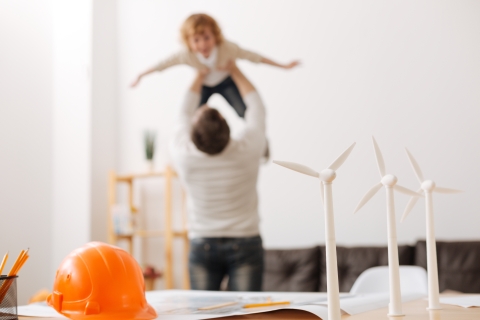
Humanising Policy: Exploring the Good and Bad of Electricity

Around 90% of households in the UK use fossil fuels, such as gas and oil, to heat their homes and hot water. The issue with fossil fuels is that they are very high carbon and therefore emit harmful greenhouse gases when burned. These gases, such as carbon dioxide, enter and trap heat in our atmosphere, creating a greenhouse effect which ultimately leads to global warming.
Another factor we are forced to consider today is that fossil fuels are a finite resource - some estimates (such as this one from Octopus Energy) predict that we could globally run out of oil, coal and natural gas by 2060. But however long our fossil resources may last, we know that we need to steadily reduce our dependence on fossil fuels and this is where electricity enters the equation. With this blog we’ll aim to share just a few of the many advantages of electricity as a viable replacement for fossil fuels, and then consider some of the potential challenges.
Electricity is good…
An immediate advantage to switching to electricity is that it could be much more time- and cost-effective than other potential alternatives – much of the basic infrastructure we need to use electricity is already in place. Adapting it for electricity isn’t the only option, however – other alternatives for fossil fuels such as hydrogen can also make use of what is already in place. But whether it is for electricity, hydrogen or another option, it will be much less complicated to use an existing system than it would be to install a brand new one into every home and building in the country, even if it will need updating and fortifying.
The complication of electricity has always been that you need to use energy to make energy. Historically, the energy mix of electricity (that is, the fuel sources that help to make it) has been very fossil fuel heavy. In particular, it has been heavily reliant on coal, which produces around double the amount of greenhouse gases as natural gas when burned. So why is this an advantage? Because the carbon intensity of electricity has fallen dramatically over the past decade.
The UK has done much to invest in adding renewables onto the grid. These produce clean (or green) energy using natural power, such as from the wind or the sun, to produce electricity. By 2035, the government aims for the electricity grid to become net zero carbon - low enough that any emissions produced will be able to be captured or offset - making it an attractive way to heat our homes.
Our third benefit to using electricity for our heating is nice and clear – the technology is tried and tested, with an established range of solutions available from all across the industry. As the transition away from fossil fuels is being enforced, having multiple options is essential as everyone’s situation can be different. If you are looking to electrify your heat, the range of choices on offer include heat pumps, and panels heaters or storage heaters in combination with a hot water heat pump. There is also plenty of opportunity for investment and innovation to help the sector grow.
…isn’t it?
The examples given above are just a few of the many benefits offered by the electrification of the grid. So there you go, all sorted – let‘s electrify everything right away! Right? Unfortunately, it isn’t that simple, and the electrification of heat does provide challenges – now we’ll consider some of those.
Let’s start by going back to the energy mix of electricity (the fuel sources that help to make it) that we mentioned earlier. The UK has indeed invested a lot of time, money, and resources into integrating clean, green energy into our electricity grid. Yet at the time of writing this, around 50% of the electricity we use is generated by fossil fuels, as shown by the GridCarbon app screenshot below. So far, the UK has mainly relied on wind turbines and solar panels to provide clean energy on the grid. But sometimes there are beautiful, still days when there is no wind to turn the turbines, or there is no sun to reach the solar panels. To move homes away from fossil fuels to electricity requires an abundance of reliable, steady energy.
It will take significant investment and time to get the grid to net zero carbon by 2035 and even if government succeeds, ‘renewable’ does not always mean ‘reliable’. It is, of course, better to supplement half our use of fossil fuels with renewables than not to use renewables at all, but ensuring there is enough renewable energy to meet demand remains a challenge to be overcome.
Next let’s consider the challenge of capacity – having enough electricity to meet the demand. In the UK, we currently have a heavy reliance on fossil fuels for our heating and hot water. If we were to move every single UK home onto an electric alternative overnight tonight, we would find that we simply do not have the energy supply available on the grid to cope with the demand.
The supply of electrical capacity is increasing, however, and it is being strengthened in anticipation of a steep rise in demand. Tariffs which make use of times when energy is in more abundance or cheaper, such as off-peak and smart time of use, are also entering the market at pace. So steps are being taken to overcome this challenge, but whilst electricity is becoming greener by the day and capacity will increase to match demand, we must be sure to make the transition at a pace which our grid can support.
The final challenge we want to consider is the understandable concern around cost. For various reasons, electricity is significantly more expensive than gas, generally at around quadruple the price per kilowatt-hour. However, this may not always be the case. This year, government is planning on consulting around changing the levies to make electricity a more attractive solution when compared to gas. They are also considering incentives to increase how insulated your home is (the better the insulation, the lower the cost of heating your space), which is a tactic already being used for new builds.
Whilst government is planning steps to help, there are things that specifiers and even homeowners can do to play a part in meeting this challenge. Did you know, for example, that heat pumps can use 1kW of ‘paid for’ energy to produce 3kW of usable energy? This can offer a possible saving for end users as well as benefitting the grid and the environment. What we each can do will be dependent on personal circumstance and means, of course, but now is the ideal time to start researching to see what options are available.
So we’ve explored some of the advantages and challenges that come with the electrification of heating. But to decarbonise our society we need to consider all the avenues, which is why government and industry are also exploring other options such as hydrogen as an alternative for fossil fuel, which offers its own challenges and potential advantages, though these are still being fully explored. But whatever the future holds, there is no doubt that electrification has a significant role to play.
At GDHV we have products to easily electrify the heating of the home, as well as the knowledge and experience which can help specifiers and end users make the most of them. Watch this space for future blogs as we will look at what products we at GDHV are making which can help lead us, as individuals and as an industry, into the future of electrified heating.











